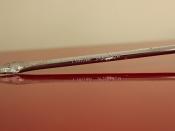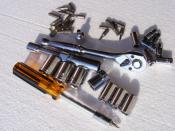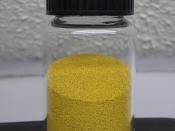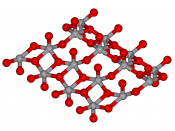Vanadium The element Vanadium is the 23rd element in the periodic table of elements. It has an atomic number of 23 and an atomic mass of 50.9415. There are two isotopes of natural Vanadium, which are: 50V (.24%) and 51V (99.76%). The electron configuration is [Ar] 4sò 3dò. The symbol for Vanadium is V. Vanadium was named after the Scandinavian goddess, Vanadis. Vanadium was first discovered in by del Rio in 1801. Unfortunately, del Rio's new element was incorrectly declared impure chromium by a French chemist. Del Rio also thought that he himself was mistaken and accepted the chemist's statement. Nils Sefström later discovered the element in 1831. Also, Roscoe isolated Vanadium in nearly pure form by reducing the chloride with hydrogen in 1867. But, Vanadium was not yet produced 99.3 to 99.8% pure until 1927. The boiling point of Vanadium is 3409ðC (6168ðF) and the melting point is 1902ðC (3455ðF).
The density is 5.8 g/cmó. Other traits of pure Vanadium are that it has a bright white color and very soft and ductile. It has a good corrosion resistance to alkalis, sulfuric and hydrochloric acid, and salt water. Structurally, it is very strong and is used in nuclear applications. Uses for Vanadium include: automobile frames, rust-resistant springs, gears, and axles. Vanadium pentoxide is used in some ceramics. Vanadium is found is varies locations around the world: Peru; United States: Colorado, Utah, Arizona and New Mexico; Germany; South-West Africa and Rhodesia. Vanadium must be handled with extreme care. Ductile Vanadium is commercially available at the cost of $40/ lb (1969). Commercial Vanadium metal, 95% pure, cost about $20/lb, and commercial Vanadium metal 99.9% pure is $100/oz.
Works Citied World Book Encyclopedia. Field Enterprises Edu. Corp. 1960. pg. 213 Vol. U-V (18) Handbook of Chemistry and Physics. The Chemical Rubber Co. 1969. pg. B-56.




